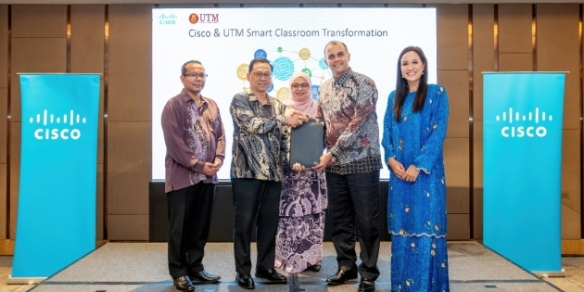Asia Pacific to be the frontline for IoT: IDC
By Digital News Asia December 19, 2014
- 2014 saw explosion of IoT-related solutions, including consumer wearables
- Expect significant adoption of wearables in the enterprise, says IDC

INTERNATIONAL Data Corporation (IDC) envisions 2015 will be the year when the Internet of Things (IoT) starts to deliver against the hype, but it will require vendors and customers alike to change their approach.
“Companies are always looking for ways to drive business transformation, deliver competitive differentiation and enhance the customer experience, and many are now realising that the Internet of Things can help them deliver against these goals,” said Charles Reed Anderson, head of Mobility and IoT at IDC Asia/Pacific.
Anderson said that 2014 has seen an explosion of new IoT-related solutions, including consumer wearables, smart-home products and industrial solutions.
“More importantly, however, is that 2014 has seen the maturing of the wider IoT technology vendor ecosystem, which helped ensure we have the capabilities to deploy complex IoT solutions today and deliver tangible value to governments, enterprise and consumers alike,” he added.
Drawing from the latest IDC research and internal brainstorming sessions amongst IDC's regional and country analysts, the following are the top 10 key IoT predictions that IDC believes will have the biggest impact on the APeJ (Asia Pacific excluding Japan) IoT industry in 2015.
1) IoT to create new markets for retail brands
During the past year, IDC has witnessed an explosion in the consumer wearables market with new fitness bands, smart watches and smart clothing being launched from traditional OEM (original equipment manufacturer) vendors and a multitude of tech startups and ‘third platform-born’ players.
IDC believes that 2015 will see an influx of consumer IoT embedded into consumer retail brands and products, the research and analyst firm said in a statement.
Partnerships between IoT vendors (including ODM/ OEM vendors) and non-tech consumer goods’ brands will emerge rapidly to create a sizable market opportunity for the IT industry.
 2) Smart watches: Early adopters will be the only adopters, for now
2) Smart watches: Early adopters will be the only adopters, for now
New smart watches will be launched on an almost weekly basis from the leading global device manufacturers, the Chinese and Taiwanese ODM (original design manufacturer) vendors and tech startups.
While interest levels are high, IDC believes the early technology adopters will be the only adopters in 2015.
The combination of the small screen size, immature application developer ecosystem, and limited functionality will prevent this from reaching the wider consumer market in 2015.
3) Wearables enter the enterprise
Basic wearables, which include devices fitness bands and clips that cannot load third party software, will find a lucrative new market in enterprise customers.
Employee tracking, integration into corporate wellness programmes, and the creation of new business models that leverage basic wearables, especially fitness bands, to enhance the customer experience will see significant adoption in 2015.
4) Free services to drive consumer IoT adoption
There is a limit to how many consumer wearable products and services consumers will be willing to purchase.
In 2015, IDC believes companies will start to offer free products and services to specific customer demographic groups, but they will insist they ‘own’ the data that is produced by the devices.
This data will then be leveraged to deliver personalised marketing and drive sales or sold to third parties (regulation permitting).
5) Emergence of the glass solution provider
Connected glass devices will struggle in the consumer market, however, the enterprise business case exists for many industries, particularly those industries (e.g. major equipment manufacturers) that employ large workforces that spend considerable time at customer sites for training as well as maintenance, repair and overhaul (MRO) services.
IDC expects some large equipment manufacturers to build out their internal capabilities and partner ecosystems to become a glass solution provider and to reduce their considerable travel costs.
6) Industrial IoT: Businesses ‘talk big’ but deploy practically
Most industries believe that IoT will forever change the way their industry operates, however, ongoing concerns about both up-front (capital expenditure) and ongoing (operating expenditure) costs as well as potential security and privacy issues will ensure the deployment of ‘practical’ solutions in 2015.
Customers will focus on deploying solutions that deliver quick impact and return on investment (e.g. energy management solutions) and leverage the cost-savings generated to fund more dynamic solutions going forward.
7) The next battlefield: The platform of platforms
Multiple platforms from multiple vendors are required to drive a single solution, whether a smart city, smart building or smart home.
Rather than focus on attempting to get every vendor and customer to adopt a single platform or standard, 2015 will see a new wave of vendors vying to become the ‘platform of platforms,’ where their management platform will become the aggregator of the multiple sub-platforms and solve the ongoing platform and standards dilemma.
8) IoT’s era of coopetition: Partner to thrive instead of survive
2015 will see solution-focused IoT partnerships, alliances, and consortiums created to focus on Asia Pacific specifically.
The new groups will bring together vendors from across the IoT ecosystem (e.g. device/ module manufacturers, application providers, security vendors) as well as end-users to target specific industry verticals, solution types (e.g. supply chain) and customer types (e.g. smart homes).
9) Beware the bubble
Most of the technologies that support IoT solutions exist today. However, the areas where the industry needs to expand and drive innovation are in the applications and analytics space.
Few companies have these capabilities internally and will seek to acquire firms that do. The combination of high demand and limited supply with unsure monetisation potential will create risky investment environment.
10) Asia Pacific becomes the frontline for IoT
On the demand side, the sheer size of the enterprise, government and consumer segments in Asia Pacific will see vendors increase their IoT go-to-market capabilities in region in an attempt capture their share of the market.
In particular, IDC believes the government, mining, energy and manufacturing industries will see the most significant growth and competition.
On the supply side, as more companies and brands increase their investments to create new IoT-enabled products and solutions to drive their future revenues, many will look to Asia Pacific’s growing list of capable and innovative OEM/ ODM vendors for partnership and joint R&D (research and development) opportunities.
IDC predicts that while IoT is still in its early phases of maturity, the enterprise and consumer market demand combined with the vendors adopting a more open-minded approach to partnering will lead to IoT moving beyond the hype in 2015.
Related Stories:
IoT to be fastest-growing IT segment in APAC: Frost
IoT will be largely driven by makers and younger startups: Gartner
Disrupt: IoT to be a goldmine for app developers
US$64bil potential for IoE in Malaysia: Cisco
For more technology news and the latest updates, follow @dnewsasia on Twitter or Like us on Facebook.


